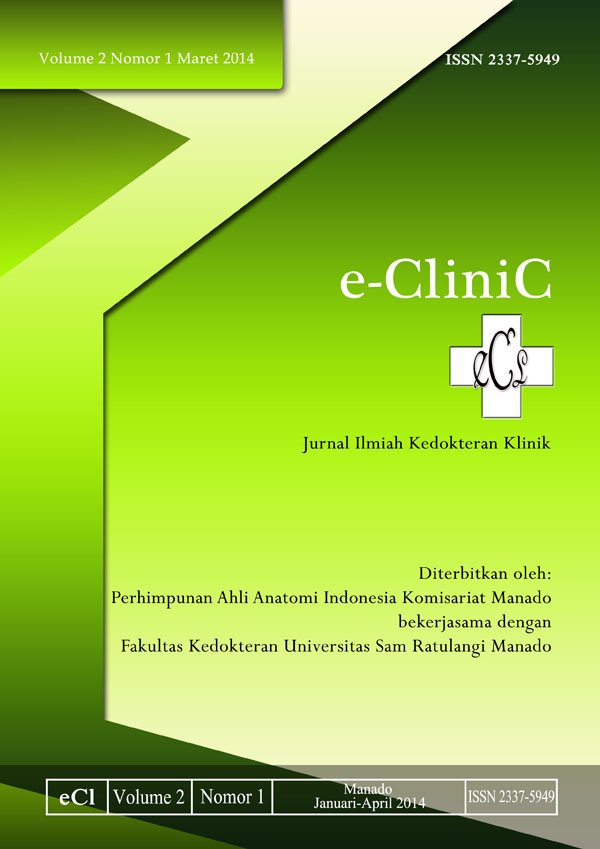HUBUNGAN KONSUMSI AIR SUMUR DI PESISIR PANTAI DENGAN HIPERKALSIURIA PADA ANAK DI PESISIR PANTAI MAASING
DOI:
https://doi.org/10.35790/ecl.v2i1.3744Abstract
Abstract: Hypercalciuria is a metabolic disorder infected in children with bladder stone. The bladder stone has a long term consequence toward the growth of the Hypercalciuria due to an increase in one of the calcium intake. Well water in the coastal area is predicted to have experience an intrusion from the sea water and contained high level of calcium. Aim – To find out the level of the calcium consumed, the urinary calcium, as well as the relations between the well water consumption in the coastal area and the hypercalciuria. Methodology – This research is using an observational analytic research design using cross sectional approach with simple random sampling tool in the village of Maasing, Tuminting, Manado, from November to December 2013. The urinary calcium level is examined to the research subject of 50 children. The water hardness level is also examined throughout 20 samples of well water. Result of the Experiment – The result of the experiment includes 30 children (60%) consumed well water and 20 children (40%) did not consume, with distribution of 27 boys (54%) and 23 girls (46%). One child (2%) is diagnosed with positive hypercalciuria and 49 negative. On the examination of the water hardness level, 19 wells (95%) contained unfeasibly consumed water and 1 well feasible. Conclusion – The well water in Maasing Coast has higher hardness value above the feasible consumption. There is no relation between the well water consumption in the coast with hypercalciuria.
Keyword: well water, hypercalciuria, children, coast
Â
Â
Abstrak: Hiperkalsiuria merupakan kelainan metabolik tersering pada anak dengan batu saluran kemih. Batu saluran kemih mempunyai konsekuensi jangka panjang terhadap tumbuh kembang Hiperkalsiuria disebabkan salah satunya oleh peningkatan intake kalsium. Air sumur di pesisir pantai diperkirakan mengalami intrusi air laut dan mengandung kadar kalsium yang tinggi. Tujuan Penelitian - Untuk mengetahui kadar kalsium air sumur yang dikonsumsi, kadar kalsium urine, serta hubungan antara konsumsi air sumur di pesisir pantai dengan hiperkalsiuria. Metode Penelitian - Penelitian ini menggunakan desain penelitian analitik observasional dengan pendekatan cross sectional dengan cara simple random sampling di Kelurahan Maasing Kecamatan Tuminting Manado dari bulan November sampai Desember 2013. Subjek penelitian sebanyak 50 anak dan dilakukan pemeriksaan kadar kalsium urine, serta 20 air sumur dilakukan pemeriksaan tingkat kesadahan air. Hasil Penelitian – Hasil penelitan didapatkan 30 anak (60%) mengonsumsi air sumur dan 20 anak (40%) tidak mengonsumsi air sumur, dengan distribusi laki-laki 27 anak (54%) dan perempuan 23 anak (46%). Hasil pemeriksaan 1 anak (2%) positif hiperkalsiuria dan 49 anak (98%) negatif hiperkalsiuria. Pada pemeriksaan kesadahan air didapatkan 19 sumur (95%) merupakan air yang tidak layak dikonsumsi dan 1 sumur layak dikonsumsi. Kesimpulan – Air sumur di pesisir pantai Maasing bernilai kesadahan diatas kelayakan konsumsi. Tidak terdapat hubungan antara konsumsi air sumur di pesisir pantai dengan hiperkalsiuria.
Kata kunci: air sumur, hiperkalsiuria, anak, pesisir pantai
Downloads
How to Cite
Issue
Section
License
COPYRIGHT
Authors who publish with this journal agree to the following terms:
Authors hold their copyright and grant this journal the privilege of first publication, with the work simultaneously licensed under a Creative Commons Attribution License that permits others to impart the work with an acknowledgment of the work's origin and initial publication by this journal.
Authors can enter into separate or additional contractual arrangements for the non-exclusive distribution of the journal's published version of the work (for example, post it to an institutional repository or publish it in a book), with an acknowledgment of its underlying publication in this journal.
Authors are permitted and encouraged to post their work online (for example, in institutional repositories or on their website) as it can lead to productive exchanges, as well as earlier and greater citation of the published work (See The Effect of Open Access).







